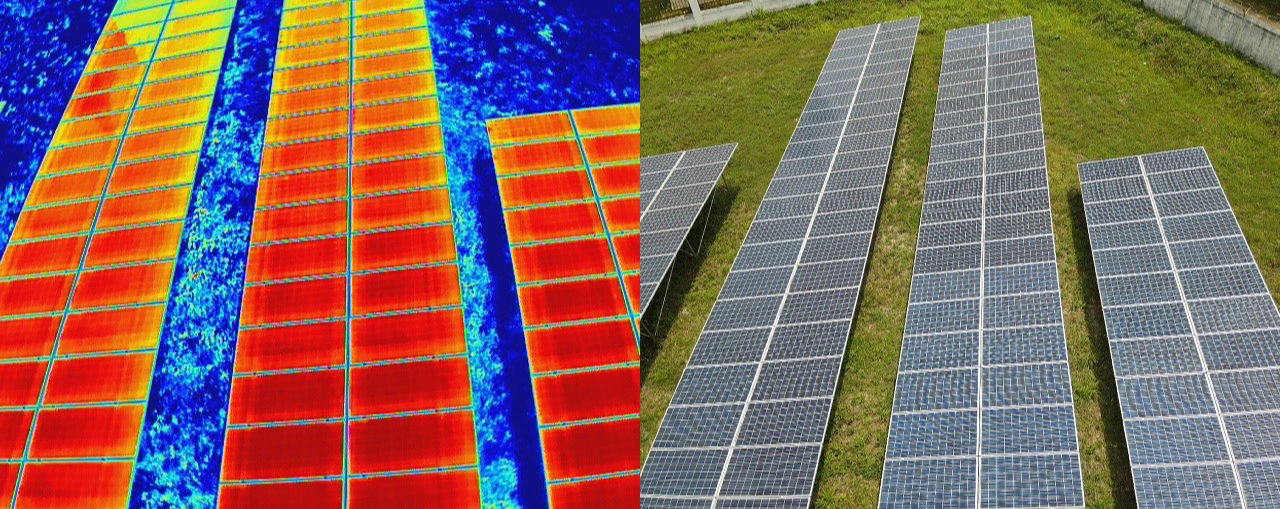การประเมินความเสียหายแผงเซลล์แสงอาทิตย์แบบติดตั้งบนพื้นดินด้วยภาพถ่าย และภาพความร้อนจากอากาศยานไร้คนขับ
DOI:
https://doi.org/10.55164/jgrdi.v1i2.2206คำสำคัญ:
ภาพความร้อน, แผงเซลล์แสงอาทิตย์, อากาศยานไร้คนขับ, การบำรุงรักษาเชิงป้องกันบทคัดย่อ
งานวิจัยนี้ นำเสนอการประเมินความเสียหายแผงเซลล์แสงอาทิตย์ด้วยภาพถ่ายและภาพความร้อนจากอากาศยานไร้คนขับในพื้นที่โครงการผลิตพลังงานไฟฟ้าจากเซลล์แสงอาทิตย์บนพื้นดินหรือโซลาร์ฟาร์มขนาดกำลังการผลิต 502.2 กิโลวัตต์สูงสุดในพื้นที่สำนักงานอธิการบดี มหาวิทยาลัยนราธิวาสราชนครินทร์ โดยมีวัตถุประสงค์ในการประเมินสภาพแวดล้อม ความสกปรก ความเสียหายภาพรวมและรายแผง และการเสื่อมสภาพของโมดูลภายในแผงเซลล์แสงอาทิตย์ ซึ่งเกิดจากการติดตั้งและการใช้งานตลอดระยะเวลา 5 ปี ของโครงการ ในการบินสำรวจสามารถจำแนกความเสียหายของแผงเซลล์แสงอาทิตย์ในโครงการ ได้แก่ รอยร้าวของกระจกหน้าแผงเซลล์แสงอาทิตย์ ความสกปรกจากสภาพแวดล้อมของแผงเซลล์แสงอาทิตย์ การบังเงาของวัชพืชต่อแผงเซลล์แสงอาทิตย์ การกัดกร่อนภายในและการหลุดลอก และการเกิดจุดความร้อนภายในแผงเซลล์แสงอาทิตย์ เป็นต้น โดยในการใช้งานอากาศยานไร้คนขับสามารถช่วยประหยัดเวลาและค่าใช้จ่ายในการดำเนินงานสำรวจตรวจสอบในกรณีที่เป็นโครงการขนาดใหญ่ อีกทั้ง สามารถนำผลที่ได้จากการสำรวจไปวางแผนการบำรุงรักษาเชิงป้องกันได้อย่างถูกต้องและเหมาะสมในอนาคต
เอกสารอ้างอิง
Subcommittee on Consideration of Laws, Structures, Duties and Powers of Agencies Related to Information Technology. (2020). Report on the Study on Guidelines for Promoting the Use of Commercial Unmanned Aircraft Technology. Senate Committee on Information, Communication and Telecommunications Technology Meeting No. 26/2020, 18 August 2020.
Narcotic Plant Survey and Monitoring Institute. (2017, February 17). Knowledge organization on unmanned aerial vehicles for narcotic plant survey. Office of the Narcotics Control Board: Ministry of Justice. http://www.oncb.go.th/ncsmi/doc3/อากาศยานไรคนขับเพื่อการสำรวจพืชเสพติด.pdf
Prommet, P., & Palasai, W. (2023). Study of predictive maintenance of wind turbines at Lam Takhong Chala Pha Wattana Power Plant, Nakhon Ratchasima Province using a group unmanned aerial vehicle combined with an artificial intelligence processing system. Electricity Generating Authority of Thailand.
Ferrara, C., & Philipp, D. (2012). Why do PV modules fail?, Energy Procedia, 15, 379-387. https://doi.org/10.1016/j.egypro.2012.02.046
Köntges, M., Kurtz, S.R., Packard, C.E., Jahn, U., Berger, K.A., Kato, K., Friesen, T., Liu, H., Iseghem, M.V., Wohlgemuth, J.H., Miller, D.C., Kempe, M.D., Hacke, P., Reil, F., Bogdanski, N., Herrmann, W., Buerhop‐Lutz, C., Razongles, G., & Friesen, G. (2014). Review of Failures of Photovoltaic Modules. Report IEA-PVPS T13-01:2014, International Energy Agency (IEA). http://iea-pvps.org/wp-content/uploads/2020/01/IEA-PVPS_T13-01_2014_Review_of_Failures_of_Photovoltaic_Modules_Final.pdf
Zou, J. -T. & Rajveer, G. V. (2022). Drone-based solar panel inspection with 5G and AI Technologies. 2022 8th International Conference on Applied System Innovation (ICASI), Nantou, Taiwan, 2022, 174-178. https://doi.org/10.1109/ICASI55125.2022.9774462
Pruthviraj, U., Kashyap, Y., Baxevanaki, E. & Kosmopoulos, P. (2023). Solar photovoltaic hotspot inspection using unmanned aerial vehicle thermal images at a solar field in South India. Remote Sensing. 15(7), 1914. https://doi.org/10.3390/rs15071914
Masita, K., Hasan, A., & Shongwe, T. (2022). 75MW AC PV module field anomaly detection using drone-based IR orthogonal images with Res-CNN3 detector. IEEE Access, 10, 83711-83722. https://doi.org/10.1109/ACCESS.2022.3194547
DJI Bangkok. (2021). DJI Mavic 2 Enterprise Advanced. https://www.djibangkok.com/shop/dji-mavic-2-enterprise-advanced

ดาวน์โหลด
เผยแพร่แล้ว
รูปแบบการอ้างอิง
ฉบับ
ประเภทบทความ
สัญญาอนุญาต
ลิขสิทธิ์ (c) 2023 บัณฑิตวิทยาลัย มหาวิทยาลัยทักษิณ

อนุญาตภายใต้เงื่อนไข Creative Commons Attribution-NonCommercial-NoDerivatives 4.0 International License.


